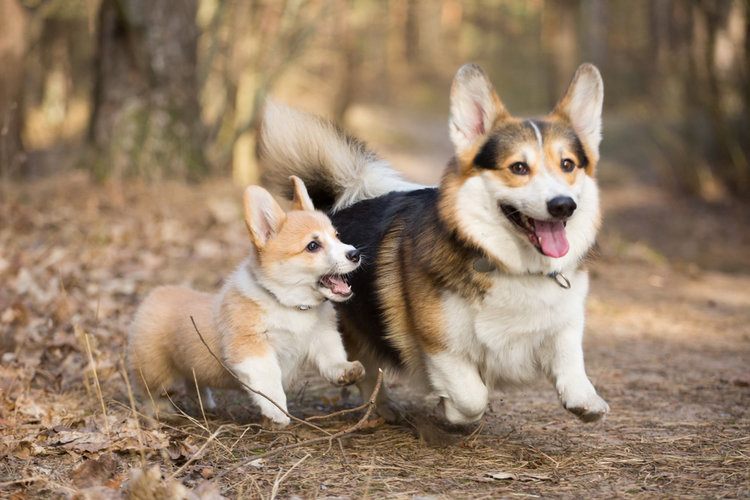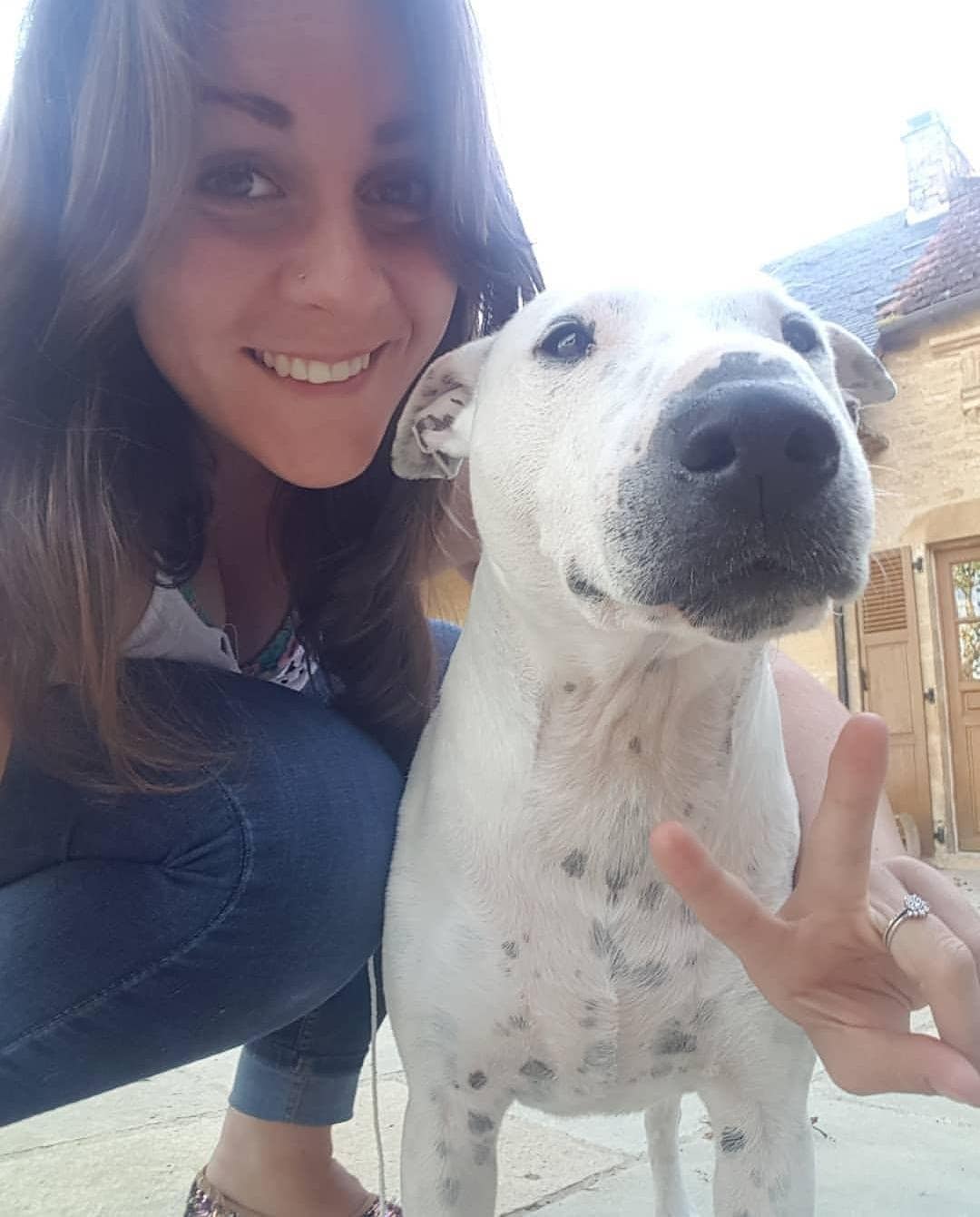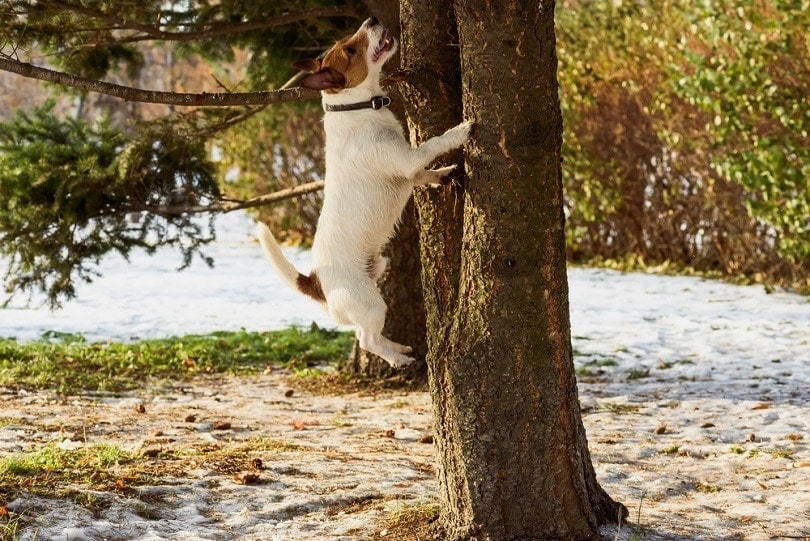Rhodesian Great Dane Mix: Care, Pictures, Info & More
Updated on
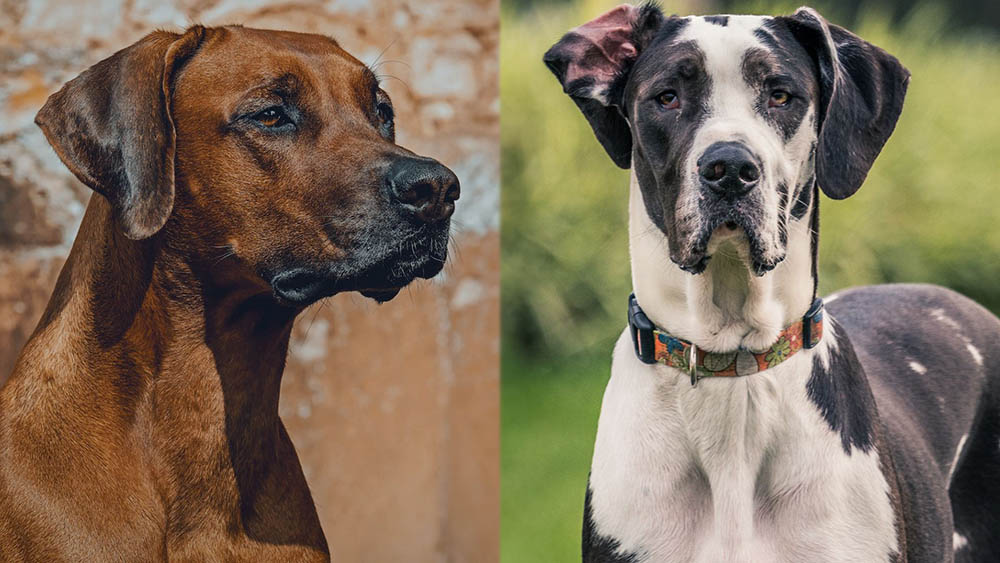
Click to Skip Ahead
One is a dog trained to hunt lions, and the other is a big, strong canine that can take down a wild boar. What do you get when you cross these two massive canines? Interestingly, the Rhodesian Great Dane mix is a big dog that, in many cases, is less of a hunter and more of a snuggler. Read on to find out much more about this fascinating designer dog.
Breed Overview
| Height: | 24–32 inches |
| Weight: | 70–150 pounds |
| Lifespan: | 7–12 years |
| Colors: | Solid yellowish-brown, wheaten, fawn, merle (charcoal with torn black patches), white, black, or black & white. |
| Suitable for: | Families with older children, active couples, experienced dog owners |
| Temperament: | Energetic, affectionate, confident, loyal, reserved with strangers |
The Rhodesian Great Dane is a large or, occasionally, massive dog, so it’s best you know how to handle a large dog, train them well, and have plenty of space to move around in and outside your home. As a mix of the Rhodesian Ridgeback and Great Dane, it would not be surprising if your Rhodesian Great Dane weighed over 100 pounds!
This designer breed offers several excellent traits for those who love big dogs. They will likely be protective and sensitive but mischievous. Rhodesian Great Danes probably won’t be all that happy when strangers come to the door, either. Sadly, the chance your Rhodesian Great Dane will live a long life is low as neither parent breed is exceptionally long-lived.
Rhodesian Great Dane Mix Characteristics
Rhodesian Great Dane Mix Puppies
One thing that’s rather difficult to do if you want a Rhodesian Great Dane is to find one. Many breeders aren’t breeding these dogs, so you might be unable to find a puppy or even an adult close to your home.
One possibility is to find a Rhodesian Great Dane mix at your local shelter, but the problem with this option is that you won’t have much knowledge about where the dog came from.
If you find a breeder, be sure to ask for the puppy’s OFA certifications. These will give you an idea of the health of their hips and elbows. You can ask your veterinarian for a wellness check to ensure your Rhodesian Great Dane puppy has been vaccinated and dewormed.
Lastly, if you find a Rhodesian Great Dane puppy, look for the following signs (below) before adopting them. If you don’t see them, you should probably look for another.
- They have no eye or nose discharge
- They are alert, bright-eyed, and curious
- They are outgoing and come to you without fear
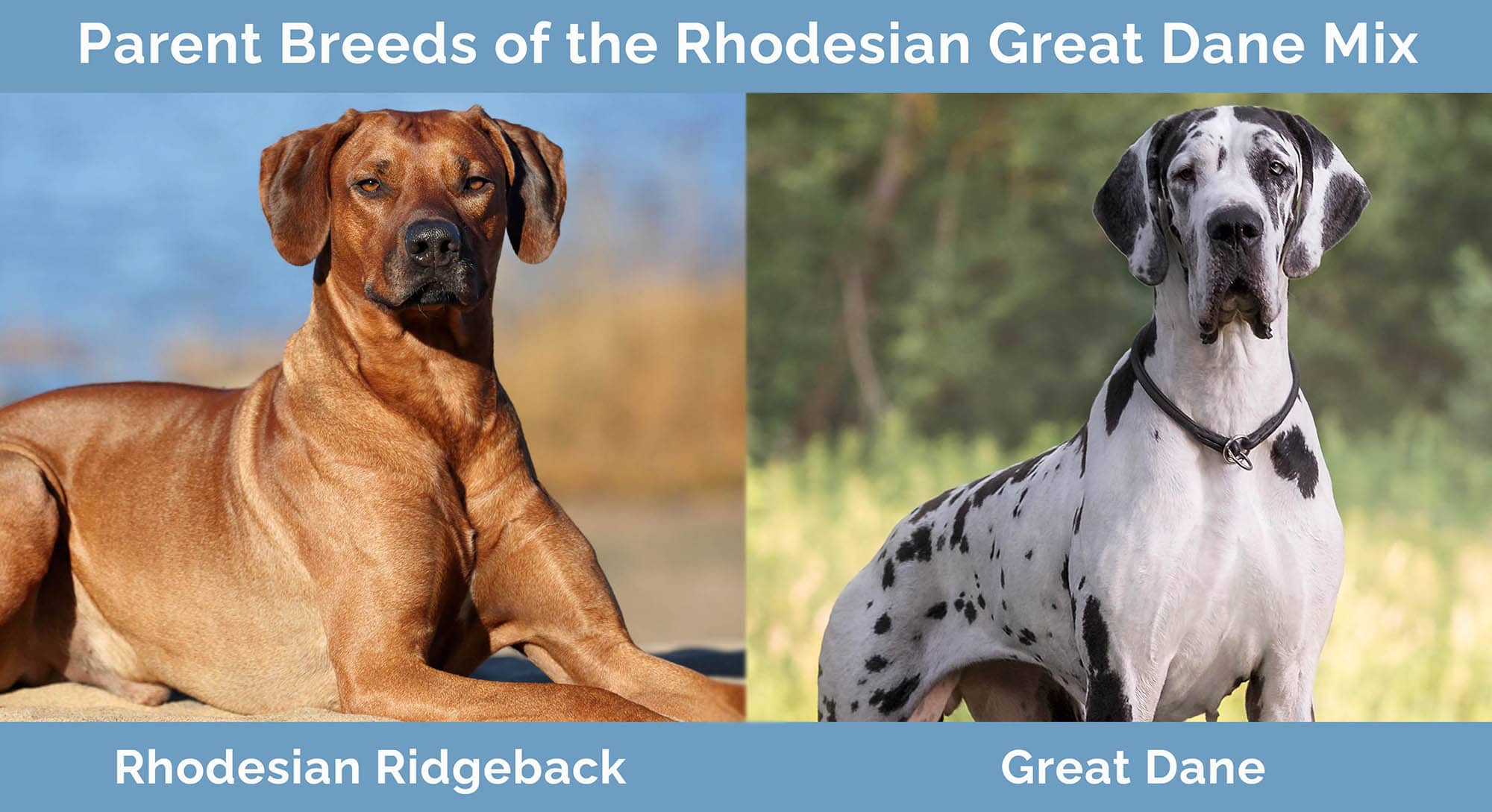
Temperament & Intelligence of the Rhodesian Great Dane Mix
One thing notable about most Rhodesian Great Dane puppies is that they’re calm and level-headed, even as puppies. Yes, they will sometimes be exuberant and a little out of control, but they’re surprisingly reserved in most cases. As they mature, most will become rather gentle and affectionate, to the point of being lap dogs.
Both parents of the Rhodesian Great Dane have a higher-than-average prey drive (and the massive body to back it up), which can be problematic. Without proper training, they will chase just about anything. The average Rhodesian Great Dane will likely be quite sensitive, intuitive, and confident.
Are These Dogs Good for Families? 👪
There’s no sugarcoating that a Rhodesian Great Dane mix is probably not a good choice for families with toddlers and small children. Some young children don’t have the maturity to realize the danger a dog presents. Most notably, small children can easily be knocked over by a large dog.
These traits aren’t a good mix for a Rhodesian Great Dane. Their prey drive is too high, and they can get anxious and aggressive quickly. However, if you have older children who are more mature around dogs, you’ll find that the Rhodesian Great Dane makes a fierce protector for them. To get the best out of your puppy, however, you’ll need to do an excellent job training and socializing them.
Does This Breed Get Along With Other Pets?
Every dog is unique, and that includes the Rhodesian Great Dane mix. Most will get along with other dogs, cats, and pets if well-socialized as puppies. However, the Rhodesian Ridgeback will chase practically anything that runs away from it simply out of instinct, which could be a problem for your neighbor’s dogs and cats. They might not tolerate living with gerbils, Guinea Pigs, rabbits, or other small pets.
Rhodesian Ridgebacks can also have a higher aggression level than average toward dogs of the same sex. As for Great Danes, they can be highly territorial, especially with dogs they don’t know. This can be problematic if your puppy is more like their Great Dane parent. While they might not be a great dog to take to the dog park, they should get along fine with the other pets in your home if socialized well.
Things to Know When Owning a Rhodesian Great Dane Mix:
Food & Diet Requirements 🦴
What’s fascinating about Rhodesian Great Danes is that they have lower caloric needs than most smaller dogs. In other words, you have to be sure not to overfeed your pet, as obesity and the problems it can cause might be the result. Maintaining their protein and fat intake will be one of your most important feeding tasks.
Also, you should feed your Rhodesian Great Dane a dog food formulated to keep a large dog healthy. That includes more than the usual amount of calcium and phosphorous (and in a balanced ratio). This specialized formula will help reduce the chance of joint issues occurring later in your dog’s life, especially hip and elbow dysplasia.
Dog food with 30% protein is recommended for Rhodesian Great Dane puppies but must be reduced to 23% once they reach adulthood. They’ll also need between 18 and 23 calories per pound per day to stay healthy and fit. Average that to 20 calories, and a 100-pound Rhodesian Great Dane would need 2,000 calories per day.
Exercise 🐕
You’ll need plenty of energy when you adopt a Rhodesian Great Dane mix because they need at least an hour or two of activity and exercise every day. Pair that with the fact that they’re large or extra-large dogs, and you can bet you’re going to get in good shape just from walking and playing with your big canine buddy.
It’s important to note that, as puppies, you shouldn’t force your Rhodesian Great Dane to undergo highly strenuous activities like 10-mile walks or agility training. The reason is that the growth plates on their elbow and hip joints (among others) can be damaged by demanding tasks and activities when they’re young, which can lead to an earlier onset of elbow or hip dysplasia.
Training 🎾
Strong-willed dogs like the Rhodesian Ridgeback can be a tough challenge when it comes to training. The same can be said of Great Danes because they’re stubborn. Put the two breeds together, and your training task will require patience, diligence, and persistence.
As mentioned, the average Rhodesian Great Dane will be a sensitive dog, and sensitive dogs do better with positive rather than negative reinforcement training methods. That means no yelling, screaming, or harsh treatment when they inevitably have an accident or act stubborn and willful.
Unless you’re a skilled and experienced dog handler and trainer, you’ll need the help of a professional trainer if you adopt a Rhodesian Great Dane. This will cost a little extra, of course, but will inevitably lead to your new canine companion being a better, more mature, and well-adjusted dog.
Grooming ✂️
Although they won’t need a lot of brushing, your Rhodesian Great Dane will be big, so brushing might take longer than with an average dog. Brushing once a week will likely be all your dog needs, but it must be done faithfully since brushing their coat stimulates the production of oils and will keep their skin healthy.
Rhodesian Great Danes usually have big, thick claws that you’ll need to trim about every 5 to 6 weeks. Unless you’re a skilled dog handler, nail clipping might be best left to a professional dog groomer. As for brushing their teeth, which is highly recommended by veterinarians, you’ll want to start when your Rhodesian Great Dane is a puppy so that they’ll be accustomed to the practice as adults.
Health and Conditions 🏥
The unfortunate fact about Rhodesian Great Dane mixes is that some will inherit the health issues of their parent breed. However, veterinarians have noted that when breeds are mixed, the likelihood of passing down the same congenital health issues is significantly lowered.
What you must remember about all large dog breeds is that, first and foremost, they live shorter lives, even if 100% healthy. Also, larger dogs suffer from hip and elbow dysplasia far more often than smaller dogs due to the weight their bodies place on their joints.
The good news is that, overall, the Great Dane and Rhodesian Ridgeback have few congenital health issues.
- Wobbler syndrome (A condition of the cervical spine)
- Hypothyroidism
- Hip and elbow dysplasia
- Epilepsy
- Dilative cardiomyopathy (A heart condition)
- Bloat
Male vs Female
Aside from the typical weight and height differences between male and female dogs, there are few others. Males are more aggressive, especially if they haven’t been neutered. Females are typically more affectionate and calm, depending on their personality.
It’s worth noting that, no matter the sex of your Rhodesian Great Dane, veterinarians recommend spaying or neutering them. This is for three reasons: to reduce their aggressiveness, lengthen their lives, and keep the stray dog population down to a minimum.
3 Little-Known Facts About the Rhodesian Great Dane Mix
1. A Rhodesian Great Dane Can Run up to 35 miles per Hour.
That’s because both parent breeds have been raised to run and hunt for hundreds of years.
2. These Dogs Might Be Too Big and Strong for Some Owners.
It can be tough to handle a 120-pound ball of energy with a high prey drive if you weigh less than they do!
3. As Big as They Are, the Rhodesian Great Dane Has Problems With Separation Anxiety.
They might look big and tough, but on the inside, they’re sensitive and need attention.
Final Thoughts
There’s no denying that a Rhodesian Great Dane mix will be a large, powerful, and strong-willed dog, which is why they aren’t recommended for everyone. You’ll need solid dog handling skills and a lot of extra time to ensure your puppy grows up to be a respectful, well-adjusted dog that’s not a danger to society (or your cat).
One thing you can be sure of when you adopt a Rhodesian Great Dane is that you’ll get a dog that needs to be socialized well, trained even better, and taught that running after small animals is not a good idea. You can also be sure you’ll get an affectionate dog that needs a lot of exercise to stay calm and healthy. We wish you the best of luck raising a wonderful canine companion.
Featured Image Credit: (L) Ilona Frey, Unsplash | (R) Earl Wilkerson, Shutterstock



